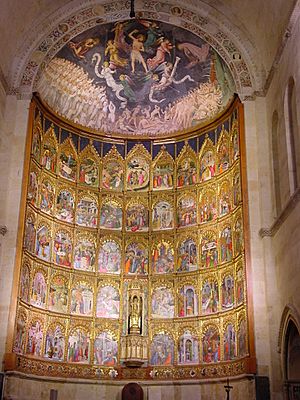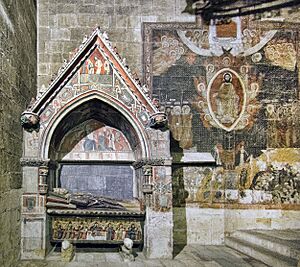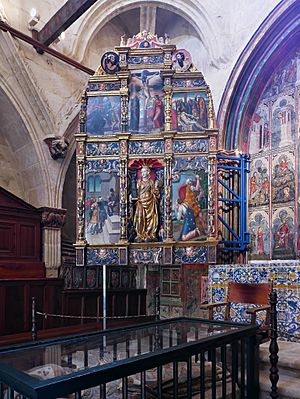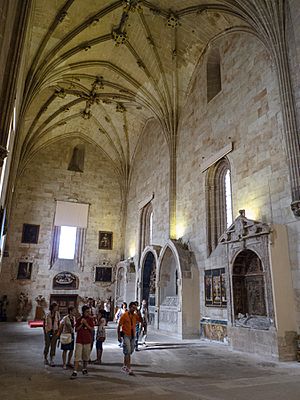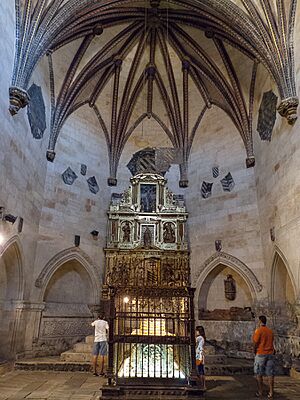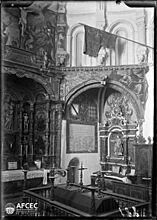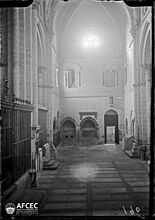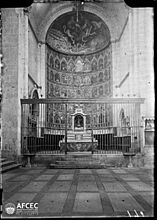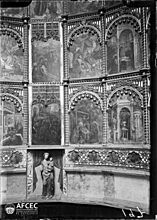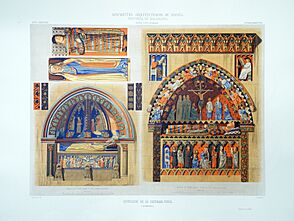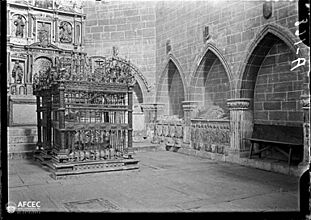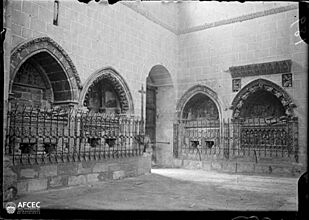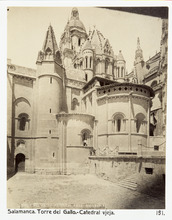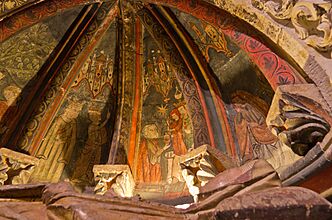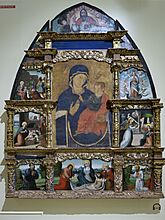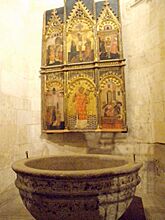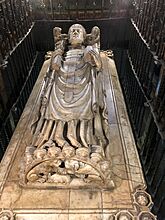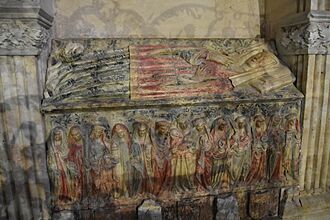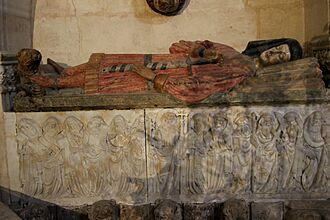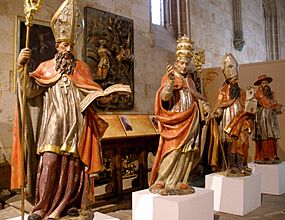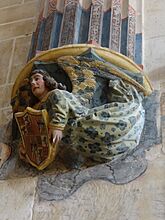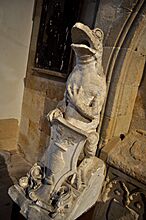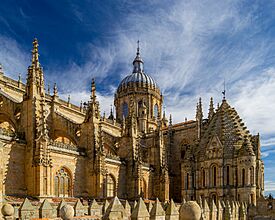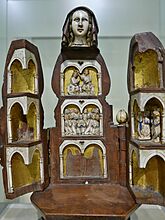Old Cathedral of Salamanca facts for kids
The Old Cathedral of Santa María (its full name is Catedral Vieja de Santa María) is one of two cathedrals in Salamanca, Spain. Bishop Jerome of Périgord started its construction in the early 1100s. It was finished by the late 1300s. The cathedral shows both Romanesque and Gothic styles. It is dedicated to Saint Mary of the See.
Contents
- What Makes the Old Cathedral Special?
- The Main Altarpiece: A Masterpiece
- The Chapel of San Martín
- The Cloister: A Rebuilt History
- The Chapel of Santa Bárbara
- Chapter Rooms: Now a Museum
- The Chapel of Santa Catalina
- The Chapel of San Bartolomé or de los Anaya
- The Casa de la Cabeza
- Images for kids
- See Also
What Makes the Old Cathedral Special?
Building the Old Cathedral began when Bishop Jerome of Périgord took charge. This was after King Alfonso VI brought people back to Salamanca. The cathedral was built during a time when Romanesque style was changing to Gothic. You can see this mix in the building. For example, the pillars were made for an older style, but the ceilings (vaults) are newer. The main part of the cathedral was finished in 1236.
Why Was the Old Cathedral Saved?
The Old Cathedral almost got torn down. When the New Cathedral was planned around 1520, people thought about demolishing the old one. But building the New Cathedral took a very long time, until 1733. People still needed a place to worship while the new one was being built. So, the old cathedral was saved. Because of the new building, one side of the Old Cathedral is narrower. Part of its cross-shaped section is also missing.
How Was the Cathedral Designed?
The cathedral is shaped like a cross, with three main sections inside. It has three round ends at the back. These ends have round-arched windows on the outside. Salamanca was a border city back then. So, the cathedral was also built like a fortress. Today, it doesn't look as much like a fortress. Its old battlements (parts of a castle wall) are gone. The roof, which used to be a walking area, is now covered with tiles. People used to call it fortis salmantina, meaning "strong Salamanca."
The Rooster Tower: A Famous Dome
The most amazing part of the cathedral is its large dome. It sits above the middle section, held up by four huge supports. This dome was likely built around 1150. Inside, it looks like an orange cut into 16 slices. Outside, it's shaped like a cone and covered with a unique scale pattern. People call it the "Torre del Gallo" (Tower of the Rooster). This is because a rooster weather vane sits at its very top. The dome has 16 columns inside and 32 windows that let in light. This dome style is similar to others in the Duero River area, like the one in Zamora.
The Main Entrance and Towers
Not much is left of the cathedral's first main entrance. A new one was built in the 1200s. Two towers stand next to it. The left tower, called the Bell Tower, is now hidden under the New Cathedral's tower. The right tower, called Torre Mocha (meaning "Cut-off Tower"), was never finished. You can still see it today. After a big earthquake in 1755, a stone slope was added to support the Bell Tower. This covered part of the new entrance.
Inside the Cathedral: Art and History
The cathedral has many interesting things inside. The main altarpiece (a large decorated screen behind the altar) is from the 1400s. It's thought to be by Nicolò Delli. Above it, a large painting shows the Last Judgment, also by Nicolò Delli. The back of the church has 53 paintings showing the life of Jesus and the Virgin Mary. Twelve of these are by the Italian artist Dello Delli.
Under the Bell Tower is the Chapel of San Martín, also known as the Chapel of Oil. Antón Sánchez de Segovia painted it in 1262. The cloister (a covered walkway) has old paintings from the 1200s and 1300s. It also has several chapels. These include the Chapel of Talavera and the Chapel of Santa Bárbara. The Chapel of Santa Bárbara was where students from the University of Salamanca took their final exams.
The Main Altarpiece: A Masterpiece
This amazing altarpiece was created between 1430 and 1450. Three artists worked on its 53 panels. The best 12 panels are by the Italian artist Dello Delli. His brothers, Sanson Delli and Nicolò Delli (also known as Niccolò Florentino), helped with other parts. Niccolò Florentino also painted the huge Last Judgment scene.
What Does the Altarpiece Show?
The altarpiece tells the story of the Virgin Mary and Jesus Christ. It starts with the birth of the Virgin and includes many scenes from Jesus's life. The whole work is topped by the powerful Last Judgment painting. The paintings were very modern for Spain at that time. They show new ideas from the Renaissance, like realistic buildings and domes. The bright colors, especially pink, make them easy to spot. They mix Italian art styles with details from Flemish painting.
The Last Judgment Painting
The Last Judgment is painted at the very top, in the curved ceiling of the apse. Jesus Christ appears to be walking forward, ready to separate good people from bad. His right hand is raised, showing both blessing and warning. His left hand is on his chest, showing the wound in his side. This image of Christ is similar to the one Michelangelo later used in the Sistine Chapel. Angels carrying symbols of Jesus's suffering surround him. Below, the Virgin Mary and John the Evangelist kneel. To Jesus's right are the saved, dressed in white. To his left are the condemned, naked and moving towards a giant monster's mouth. You can even see a bishop and a Pope among the condemned. This shows that no one is free from God's judgment.
The Virgin of la Vega
The altarpiece is watched over by a wooden statue called the Virgin of la Vega. She is the patron saint of Salamanca. The statue is covered in gold-colored bronze, with enamel and jewels. It came from an old monastery that no longer exists. This statue is from the 1100s and follows a Byzantine style. She holds the child Jesus on her lap and shows him to everyone.
The Chapel of San Martín
This chapel is under the Bell Tower. The current tower of the New Cathedral was built on top of it. It's thought that Saint Martin was a very French saint. So, he was given a small chapel at the front of the cathedral. Just before you enter the chapel, there's a large painting on the wall. It shows Saint Martin sharing his cloak.
Paintings and Tombs in the Chapel
The most interesting things in this chapel are its paintings. They have coats of arms from the Kingdom of León and Castile. Some are dated 1262 and were painted by Antón Sánchez de Segovia. They show figures like Jeremiah, Isaiah, and Daniel. On a side wall, there's a 1500s painting of the Last Judgment. It looks like a tapestry. It shows Jesus Christ surrounded by Apostles and the Virgin. He separates the saved from the condemned.
The chapel also holds several tombs. One belongs to Bishop Rodrigo Díaz, who died in 1339. It has paintings from that time showing the Adoration of the Magi. Another tomb holds the remains of the chapel's founder, Pedro Pérez, who died in 1262.
The Cloister: A Rebuilt History
The original cloister was damaged in the 1755 Lisbon earthquake. The cloister you see today was rebuilt later. On its east and south sides, there are several chapels. In 2013, it was discovered that the original cloister was taken apart. It was rebuilt on a private estate in Catalonia. This news caused a lot of discussion.
The Chapel of Santa Bárbara
Bishop Bishop Lucero founded this chapel in 1334. His tomb is in the middle of the chapel. It has a small altarpiece with paintings of Christ's death and passion. There's also a statue of Saint Barbara from the 1500s. The front of the altar has beautiful Talavera de la Reina pottery decorations.
University Exams in the Chapel
From the very beginning of the University of Salamanca, this chapel was used for final exams. Students taking their degree or doctorate exams would spend the whole night here. They would sit on a chair, resting their feet on Bishop Lucero's tomb. They would study for their defense. The next morning, professors would come and question the student about their work.
If a student passed, they would leave through the main cathedral door. Their friends would be waiting to celebrate. If they earned a doctorate, their friends would write "Victory!" on a wall, often with the student's name. Later, doctoral students had to offer a bull for a celebratory meal. This meant only wealthy students could get a doctorate. If a student failed, they left through a different door. This door was known as the "cart door." No friends or party waited for them there.
A Hidden Discovery
In February 2020, workers restoring the chapel made an exciting discovery. They took apart the 1500s altarpiece for cleaning. Behind it, they found an even older altarpiece with Gothic paintings. These paintings showed the life of Saint Barbara. Now, a special moving structure allows both altarpieces to be seen. The newer one can be moved to reveal the older Gothic one.
Chapter Rooms: Now a Museum
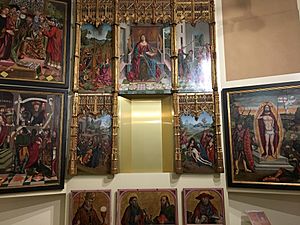
These rooms were built in 1526. Today, they are the Cathedral Museum. They hold many paintings owned by the cathedral. Three important works by Fernando Gallego from the late 1400s are here.
One of his most famous paintings is a triptych (a three-part painting) showing the Martyrdom of Saint Catherine. It's painted in a Flemish style. You can see this in the raised floors and the way lines go diagonally. Gallego's work is known for its detail and realism. For example, in the panel where an executioner cuts off the Saint's head, the cut is so fresh the head is still half-fallen. Another painting shows Jesus carrying the cross. A soldier kicks Christ, and another sticks out his tongue to insult him. These details are typical of Flemish painting from the 1400s.
One room has a beautiful wooden ceiling in Mudéjar style, with Renaissance decorations. It was made by Pedro Nieto. This room also has a painting by Fernando Gallego showing the Birth of Christ. A third room displays works by Pedro Bello, a student of Fernando Gallego, from around 1500.
The Chapel of Santa Catalina
The Chapel of Santa Catalina, also called the Chapel of Song, was founded in the 1100s. It was later made bigger in the 1400s to hold the chapter library. It is the largest chapel in the cloister.
Over time, this chapel had many uses. It was where students from the University of Salamanca took exams to get their bachelor's degrees. It also hosted important church meetings and music lessons. This is why the tomb of music master Manuel Doyagüe is here. In the 1900s, it became a storage room for art. After being restored in 2018, it is now used for cultural events like concerts and talks.
The Chapel of San Bartolomé or de los Anaya
In the middle of this chapel is the tomb of its founder, Diego de Anaya Maldonado. He was a bishop of Salamanca and a supporter of Saint Bartholomew. He also founded the oldest college in Salamanca. His tomb is made of alabaster, possibly by a German artist. It is surrounded by a beautiful grille from the 1500s. Other members of the Anaya family are also buried here. Two of their tombs still have their original colors. This chapel was updated in the 1500s, which you can see in its star-shaped ceiling.
The chapel also has one of the oldest organs, from the 1500s. It sits on a beautiful Mudéjar-style platform. The front of the organ has paintings of the Annunciation of the Virgin. The organ still works perfectly today.
The Casa de la Cabeza
This 1500s house is next to the Chapel of Santa Catalina. It has a door facing Gibraltar Street, across from the Casa Lis. It might have once been a smaller college. A carving of Saint James the Great's head on its front gave the house its name ("House of the Head"). The house was also used by cathedral members. It later fell apart. Now, it's part of the cathedral's tourist route. It has a rest room, toilets, a souvenir shop, and the exit. You can also see old archaeological remains here, including two columns that might have been part of the cathedral's original Romanesque cloister.
Images for kids
See Also
 In Spanish: Catedral Vieja de Salamanca para niños
In Spanish: Catedral Vieja de Salamanca para niños
- New Cathedral, Salamanca
- History of medieval Arabic and Western European domes


